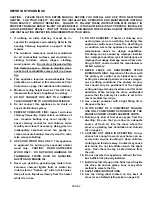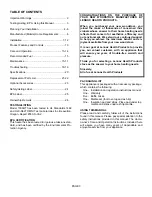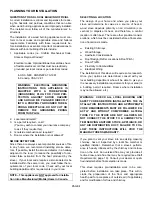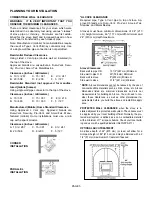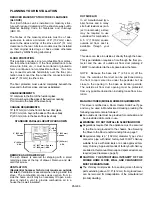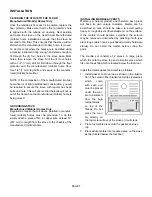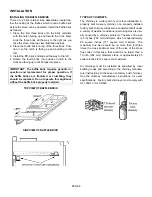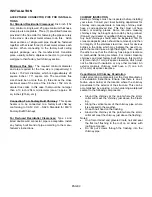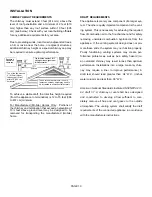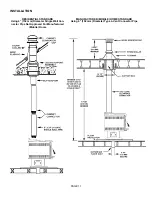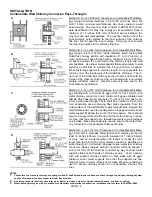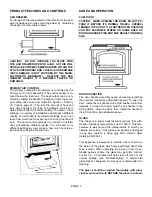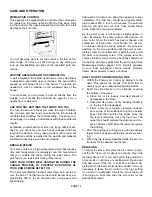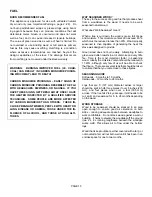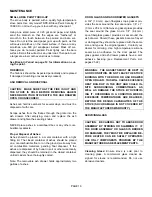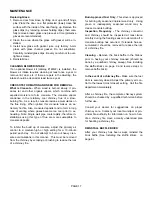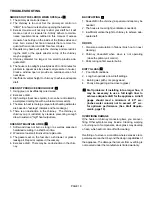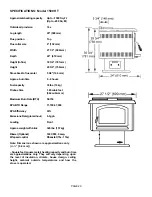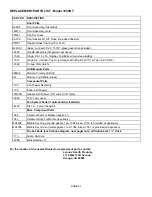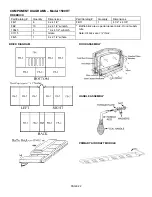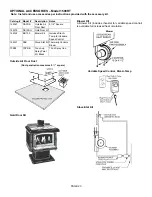
INSTALLATION
PAGE 9
ACCEPTABLE CONNECTOR PIPE FOR INSTALLA-
TIONS
For Standard Residential Clearances:
Six 6 inch (152
mm) minimum, single wall, 25 gage minimum thickness,
stove pipe is acceptable. Three (3) pre-drilled holes are
provided in the flue collar for fastening the pipe securely
to the stove. Use sheet metal screws to do this. Addi-
tional sections of single wall pipe should be fastened
together with at least three (3) sheet metal screws each
section. When connecting to the factory built ceiling
support package, use the manufacturer's transition
piece, usually called a dripless connector, to join single
wall pipe to their factory built chimney section.
Minimum Flue Size:
The required minimum diameter
and area required for the flue size is (respectively) 6
inches / 152 mm diameter, which is approximately 28
square inches / 711 square mm. The maximum flue
size should be no more than (3) three times the cross
sectional area of the size of the 6 inches / 152 mm di-
ameter flue collar. In this case, that would be no larger
than a 10 inch (254 mm) diameter (area = approx. 85
sq. inches [216 sq. cm]).
Connection To A Factory Built Chimney:
This space
heater is to be connected to a factory-built chimney
conforming to CAN / ULC – S629, Standard for 650
°
C
Factory-Built Chimneys.
For Reduced Residential Clearances:
Type L and
listed double wall connector pipe is acceptable. Install
any factory built brand of pipe according to the manu-
facturer's instructions.
CHIMNEY INSPECTION
Existing chimneys must be inspected before installing
your stove. Consult your local building department for
chimney code requirements. A masonry chimney must
have a code approved liner. This liner must not have
broken or missing pieces. Some non-code masonry
chimneys may be brought up to code by being relined.
(Consult your dealer or qualified chimney sweep). Fac-
tory built chimneys should also be inspected, first for
creosote deposits (which should be removed), and then
for integrity of the stainless steel liner. Look for obvious
bulges in the lining which may indicate the need to re-
place that section (use a bright flashlight). Also, inspect
the attic to see that the chimney has proper clearance
to combustible framing members. For interior masonry
chimneys and most factory built chimneys, this must be
a (2) two inch (51 mm) air space clearance, which must
not be filled with insulation or any other material. An
exterior masonry chimney must have a (1) one inch
(25.4 mm) air space clearance.
Vapor Barrier At Chimney Penetration
Install all venting components per the Vent Manufactur-
ers installation instructions. Ensure that there is an ef-
fective vapor barrier at the location where the chimney
penetrates to the exterior of the structure. This can be
accomplished by applying a non-hardening waterproof
sealant to the following components:
•
Around the chimney at the point where the storm
collar will meet the chimney just above the Flash-
ing.
•
Along the vertical seam of the chimney pipe, where
it is exposed to the weather.
•
On each nail head on the flashing.
•
Around the chimney at the point where the storm
collar will meet the chimney just above the flashing.
Notes:
•
On a flat or tarred and graveled roofs, nail and seal
the flat roof flashing to the roof on all sides with
roofing compound.
•
Do not put screws through the flashing into the
chimney pipe.
Содержание EARTHSTOVE 1500HT
Страница 24: ...SAFETY LISTING LABEL PAGE 24...
Страница 25: ...EPA LABEL PAGE 25...
Страница 27: ...1110 West Taft Avenue Orange CA 92865...


